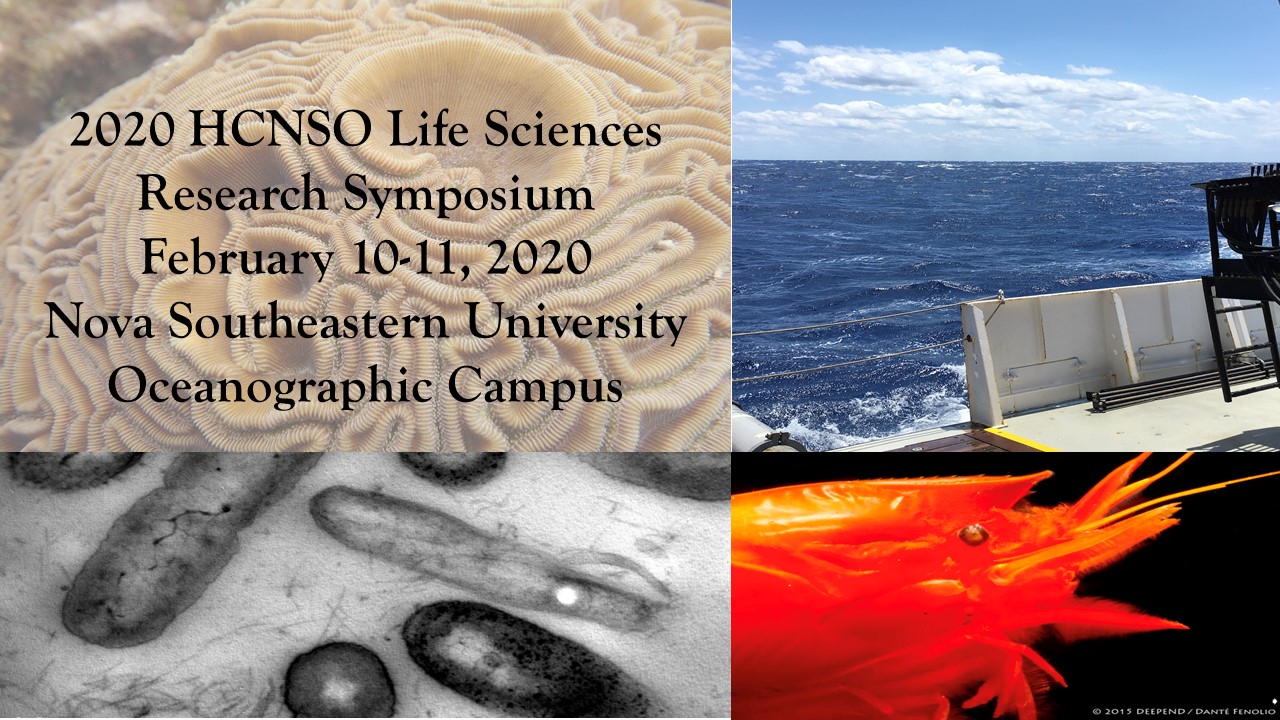Atlantic Spotted Dolphin (Stenella frontalis) and Bottlenose Dolphin (Tursiops truncatus) Nearshore Habitat Utilization, Bimini, The Bahamas
Location
HCNSO Guy Harvey Oceanographic Center Nova Southeastern University
Start
2-11-2020 3:45 PM
End
2-11-2020 4:00 PM
Type of Presentation
Oral Presentation
Abstract
Bimini, The Bahamas include two islands surrounded by a diverse assemblage of ecosystems and a large array of organisms, including two delphinid species, Atlantic spotted dolphins (Stenella frontalis) and common bottlenose dolphins (Tursiops truncatus, inshore ecotype). Distribution and sighting data of both delphinid species have been collected since 2003 (Dolphin Communication Project). Baseline group composition by species and nearshore habitat utilization exist (Melillo-Sweeting et al. 2015), but an investigation by age class or sex does not. Since this initial study, several potentially influential events have occurred, including Atlantic spotted dolphin immigration, hurricanes, continued and varied tourism and boating, pier construction (dredging, pile driving) and new-use phase of the commercial pier. This study examines Atlantic spotted and bottlenose dolphins’ use of coastal areas immediately offshore of Bimini, with attention to potential age class and sex variation for years 2003-2018. Studies on resident dolphin populations from around the world have shown significant differences in distribution by sex (Michaud, 2005; Ruckstuhl & Neuhaus, 2005; Rossman et al., 2015; Sprogis et al., 2018), with change in seasons (Ridgway & Harrison, 1998; Wells & Scott, 1998), by predation and prey availability (Heithaus, 2001; Heithaus & Dill, 2002), and by habitat preference, as well as differences with age (Toth et al., 2011). Analyses from 2003-2018 show significant differences in location by species, year and month (p < 0.01). There were also significant differences in age classes relating to calves and adults (p < 0.01). No differences were found with between sexes. A comprehensive analysis of age class and sex differences for both delphinid species help identify group composition and behavior at this location.
Atlantic Spotted Dolphin (Stenella frontalis) and Bottlenose Dolphin (Tursiops truncatus) Nearshore Habitat Utilization, Bimini, The Bahamas
HCNSO Guy Harvey Oceanographic Center Nova Southeastern University
Bimini, The Bahamas include two islands surrounded by a diverse assemblage of ecosystems and a large array of organisms, including two delphinid species, Atlantic spotted dolphins (Stenella frontalis) and common bottlenose dolphins (Tursiops truncatus, inshore ecotype). Distribution and sighting data of both delphinid species have been collected since 2003 (Dolphin Communication Project). Baseline group composition by species and nearshore habitat utilization exist (Melillo-Sweeting et al. 2015), but an investigation by age class or sex does not. Since this initial study, several potentially influential events have occurred, including Atlantic spotted dolphin immigration, hurricanes, continued and varied tourism and boating, pier construction (dredging, pile driving) and new-use phase of the commercial pier. This study examines Atlantic spotted and bottlenose dolphins’ use of coastal areas immediately offshore of Bimini, with attention to potential age class and sex variation for years 2003-2018. Studies on resident dolphin populations from around the world have shown significant differences in distribution by sex (Michaud, 2005; Ruckstuhl & Neuhaus, 2005; Rossman et al., 2015; Sprogis et al., 2018), with change in seasons (Ridgway & Harrison, 1998; Wells & Scott, 1998), by predation and prey availability (Heithaus, 2001; Heithaus & Dill, 2002), and by habitat preference, as well as differences with age (Toth et al., 2011). Analyses from 2003-2018 show significant differences in location by species, year and month (p < 0.01). There were also significant differences in age classes relating to calves and adults (p < 0.01). No differences were found with between sexes. A comprehensive analysis of age class and sex differences for both delphinid species help identify group composition and behavior at this location.


